
When I began processing the collection of Cantor Joseph Cysner, while serving as archivist for the Jewish Historical Society of San Diego, I began to entertain the idea of making his story and its related areas of Holocaust scholarship the focus of my PhD research. During my first quarter of studies in the Public History PhD Program at UC Santa Barbara (Fall 2003), I was actively engaged in the preservation and cataloging of the Cysner Collection. As questions about his World War II expulsion and rescue experiences in Germany, Poland, The Philippines, and then in the USA arose, finding the answers to those questions became a quest that has impassioned my graduate studies ever since. I knew that if I pursued his story with all of its international facets then I would have to travel extensively in the acquisition of the primary documentation and information that would necessarily validate this as a legitimate PhD dissertation project in Holocaust Studies. The looming question became how to finance such a venture. Fate would have it that in the Spring of 2004 I was informed by the US State Department of Education that I was going to be awarded The Jacob K. Javits Fellowship in Graduate Studies that would support my education and research expenses for the next four years and that financial blessing has made all the difference in my ability to pursue my information gathering quest around the world.

It goes without saying that my first source of information was and is the Cysner Collection housed in the Jewish Historical Society of San Diego Archives and because of Cysner's remarkable story that lay within, his escape from Zbaszyn Internment in Poland and immigration to the port city of Manila in The Far East, I knew that further research needs would take me to The Philippines, Poland, Germany, the East Coast of the US, possibly Israel, and other places that I as yet couldn't imagine. Here I will lay out my research travels in the order that they were performed, along with the results of my inquiries.

For the purpose of writing a pre-dissertation research paper focusing on one aspect of the Manila Rescue Story, I wanted to investigate how the immigration of Jewish refugees into The Philippines was accomplished during a time when the U.S. State Department was generally opposed to Jewish refugee immigration and had actually advised American Consuls in Europe to apply a very strict interpretation of the Immigration Laws so as to limit the number of qualifying immigrants to numbers far below the already inhibiting quota numbers. How did immigration into The Philippines fit into this scenario?
 Most of my research that summer was conducted at The National Archives II, NARA II, at College Park, Maryland. It is a huge, modern facility with state of the art equipment. Here my research concentrated on State Dept. record groups from 1935 through 1945 dealing with foreign affairs and immigration issues of The Commonwealth Nation of The Philippines, whose foreign affairs were under the purview of the U.S. State Department, War Department. Most of my research that summer was conducted at The National Archives II, NARA II, at College Park, Maryland. It is a huge, modern facility with state of the art equipment. Here my research concentrated on State Dept. record groups from 1935 through 1945 dealing with foreign affairs and immigration issues of The Commonwealth Nation of The Philippines, whose foreign affairs were under the purview of the U.S. State Department, War Department.
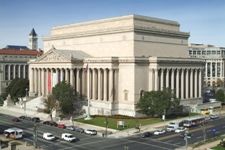 National Archives I, NARA I, near Independence Mall in Washington D.C. is a grand old building where the most important documents of American history are stored. The archives reading rooms reflected the same kind of ancient ambiance and I have to say that the photocopy room was just one step up from being a dungeon at that time. Here I found the Visa records for the Jewish immigrants who came to The Philippines. National Archives I, NARA I, near Independence Mall in Washington D.C. is a grand old building where the most important documents of American history are stored. The archives reading rooms reflected the same kind of ancient ambiance and I have to say that the photocopy room was just one step up from being a dungeon at that time. Here I found the Visa records for the Jewish immigrants who came to The Philippines.

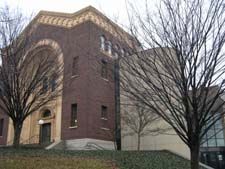 At the Hebrew Union College - Jewish Institute of Religion in Cincinnati, Ohio, Dr. Weiman of the Center for Holocaust and Humanity Education hosted an exhibit of material items and documents highlighting the story of the Frieder Brothers, philanthropic American-Jewish businessmen in the Philippines who were instrumental is proposing and organizing the Jewish Refugee Committee in Manila and its plan to facilitate the immigration of refugee Jews to Manila. At the Hebrew Union College - Jewish Institute of Religion in Cincinnati, Ohio, Dr. Weiman of the Center for Holocaust and Humanity Education hosted an exhibit of material items and documents highlighting the story of the Frieder Brothers, philanthropic American-Jewish businessmen in the Philippines who were instrumental is proposing and organizing the Jewish Refugee Committee in Manila and its plan to facilitate the immigration of refugee Jews to Manila.

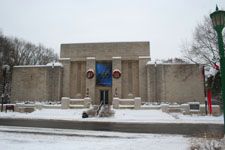 At the Lilly Library, University of Indiana, I accessed specifically the collection of Paul V. McNutt, who had been the U.S. High Commissioner of the Philippines from 1937-1939, and then returned to the Philippines as its first U.S. Ambassador after WWII in 1946. Paul McNutt played a pivotal role in organizing the program that allowed over 1300 European Jews to find a safe haven in the Philippines from Nazi tyranny in Europe. At the Lilly Library, University of Indiana, I accessed specifically the collection of Paul V. McNutt, who had been the U.S. High Commissioner of the Philippines from 1937-1939, and then returned to the Philippines as its first U.S. Ambassador after WWII in 1946. Paul McNutt played a pivotal role in organizing the program that allowed over 1300 European Jews to find a safe haven in the Philippines from Nazi tyranny in Europe.

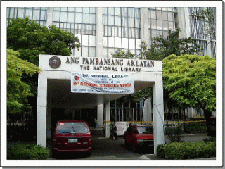 The National Library of the Philippines, in the capital city of Manila, houses the personal papers of Manual Quezon, the first president of the Philippine Commonwealth from 1936 to his death while in exile in 1945. Pres. Quezon was part of the trio of rescuers who aided the refugee Jews of Europe in obtaining U.S. Visas for immigration into The Philippines. Pres. Quezon's personal ethics and generous nature were evident throughout his collection. The National Library of the Philippines, in the capital city of Manila, houses the personal papers of Manual Quezon, the first president of the Philippine Commonwealth from 1936 to his death while in exile in 1945. Pres. Quezon was part of the trio of rescuers who aided the refugee Jews of Europe in obtaining U.S. Visas for immigration into The Philippines. Pres. Quezon's personal ethics and generous nature were evident throughout his collection.
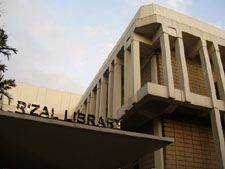 Housed at the Rizal Library of the Ateneo de Manila University of the Philippines is the 206-volume "American Historical Collection." The collection was originally located at the U.S. Embassy on Roxas Boulevard, and subsequently at the Thomas Jefferson Library in Makati. In 1991, the collection was moved to its current location in the Rizal Library at Ateneo de Manila. The collection is owned, in trust, by the American Association of the Philippines (AAP) and is managed on a day-to-day basis by the staff of Ateneo de Manila. Housed at the Rizal Library of the Ateneo de Manila University of the Philippines is the 206-volume "American Historical Collection." The collection was originally located at the U.S. Embassy on Roxas Boulevard, and subsequently at the Thomas Jefferson Library in Makati. In 1991, the collection was moved to its current location in the Rizal Library at Ateneo de Manila. The collection is owned, in trust, by the American Association of the Philippines (AAP) and is managed on a day-to-day basis by the staff of Ateneo de Manila.
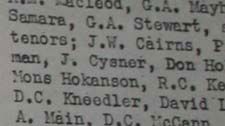 Of special value to my research were the bound volumes of the "STIC," the weekly newsletter of the Santo Tomas Internment Camp for enemy civilians of the Imperial Nation of Japan during WWII, along with other publications pertaining to the civilian internment at Santo Tomas. This newsletter of March 31, 1942 mentioned J. Cysner as a member of the camp's Male Chorus. Of special value to my research were the bound volumes of the "STIC," the weekly newsletter of the Santo Tomas Internment Camp for enemy civilians of the Imperial Nation of Japan during WWII, along with other publications pertaining to the civilian internment at Santo Tomas. This newsletter of March 31, 1942 mentioned J. Cysner as a member of the camp's Male Chorus.
 This episode of Cantor Cysner's life lasted 9 months from February 1942 to September 1942, before he was conditionally released by the Japanese to live outside the bounds of the camp, which housed as many as 5,000 prisoners for 3 years, from February 1942 until the liberation of the Philippines in March 1945. Here Joseph Cysner is listed with those who have been conditionally released. This episode of Cantor Cysner's life lasted 9 months from February 1942 to September 1942, before he was conditionally released by the Japanese to live outside the bounds of the camp, which housed as many as 5,000 prisoners for 3 years, from February 1942 until the liberation of the Philippines in March 1945. Here Joseph Cysner is listed with those who have been conditionally released.
 University of Santo Tomas is the site of the internment of thousands of enemy civilians by the Japanese during WWII. Seeing the hallways and courtyards where the internees actually lived made the personal accounts of the internees' testimonies much more meaningful. I was able to acquire names and addresses of survivors from the camp, whom I can contact for future interviews. University of Santo Tomas is the site of the internment of thousands of enemy civilians by the Japanese during WWII. Seeing the hallways and courtyards where the internees actually lived made the personal accounts of the internees' testimonies much more meaningful. I was able to acquire names and addresses of survivors from the camp, whom I can contact for future interviews.
 UST houses items of historical significance to its own WWII history, which includes pictures of internees' living conditions, newspapers, rosters of inmates, and personal experiences of life in the camp. UST houses items of historical significance to its own WWII history, which includes pictures of internees' living conditions, newspapers, rosters of inmates, and personal experiences of life in the camp.
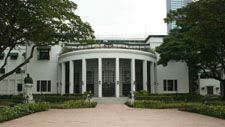 My invitation for a personal tour of the U.S. Embassy in Manila was certainly a highlight of my trip and allowed me to better appreciate the necessary diplomatic and political relationships of the US and The Philippines during and after WWII. We discussed our mutual hope to host a symposium on the Diaspora of Jews to the Far East at the U.S. Embassy in Manila. My invitation for a personal tour of the U.S. Embassy in Manila was certainly a highlight of my trip and allowed me to better appreciate the necessary diplomatic and political relationships of the US and The Philippines during and after WWII. We discussed our mutual hope to host a symposium on the Diaspora of Jews to the Far East at the U.S. Embassy in Manila.

 My husband and I visited London for a week prior to my departure to Israel for two more weeks of archival research. While in London, I took the opportunity to visit Joan Nagler, Sylvia Cysner's sister-in-law, who lives in the Highgate area of London. Joan was married to Sylvia's brother, Lee, and during our visit I videotaped our interview as she shared all she knew about Sylvia's escape from Germany just following Kristallnacht. My husband and I visited London for a week prior to my departure to Israel for two more weeks of archival research. While in London, I took the opportunity to visit Joan Nagler, Sylvia Cysner's sister-in-law, who lives in the Highgate area of London. Joan was married to Sylvia's brother, Lee, and during our visit I videotaped our interview as she shared all she knew about Sylvia's escape from Germany just following Kristallnacht.
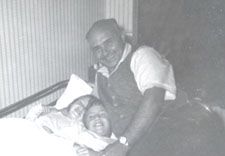 While visiting with Joan, she brought out a trove of family pictures and I used my high resolution Canon Digital Camera to photograph many of her family photographs, as they pertained to the Cysner family. Here is a rare picture of Cantor Joseph Cysner with two of his three daughters. This picture was probably taken in the late 1950s, since the oldest daughter, Charlotte, was 10 years old when her father died in San Diego in 1961. While visiting with Joan, she brought out a trove of family pictures and I used my high resolution Canon Digital Camera to photograph many of her family photographs, as they pertained to the Cysner family. Here is a rare picture of Cantor Joseph Cysner with two of his three daughters. This picture was probably taken in the late 1950s, since the oldest daughter, Charlotte, was 10 years old when her father died in San Diego in 1961.

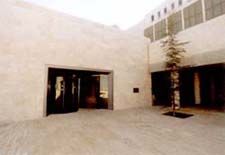 My visit to Israel brought me into contact with some of the most prestigious repositories for Holocaust documents in the world. Being able to visit with Nadia Kahan, Director of the Archives at Yad Vashem in Jerusalem once again demonstrated to me how anxious the world of Holocaust studies is to have more information on the subject of Jewish rescue in the Philippines. Nadia graciously accepted a copy of my pre-dissertation paper to place into their archives. My visit to Israel brought me into contact with some of the most prestigious repositories for Holocaust documents in the world. Being able to visit with Nadia Kahan, Director of the Archives at Yad Vashem in Jerusalem once again demonstrated to me how anxious the world of Holocaust studies is to have more information on the subject of Jewish rescue in the Philippines. Nadia graciously accepted a copy of my pre-dissertation paper to place into their archives.
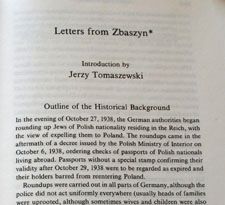 One of the drawbacks of conducting primary research on a topic that has been virtually invisible in the academic world of Holocaust studies is finding the sources that you need. The story of the Polenaktion and the Zbaszyn deportation and internment is one of those topics in Holocaust studies that has been overlooked, or should I say, overshadowed by other stories - in this case the shadow cast by Kristallnacht over the history of Zbaszyn. The Yad Vashem archives has a collection of correspondence from victims of the Zbaszyn deportation that had been accessed by Jerzy Tomaszewski and outlined in a monograph published in the 19th volume of the Yad Vashem Studies journal in 1988. What makes this find so important for me is that I have copies of the items of correspondence in the collection, many written in languages I cannot read. This article by Tomaszewski helps me in using these primary documents for my own research. One of the drawbacks of conducting primary research on a topic that has been virtually invisible in the academic world of Holocaust studies is finding the sources that you need. The story of the Polenaktion and the Zbaszyn deportation and internment is one of those topics in Holocaust studies that has been overlooked, or should I say, overshadowed by other stories - in this case the shadow cast by Kristallnacht over the history of Zbaszyn. The Yad Vashem archives has a collection of correspondence from victims of the Zbaszyn deportation that had been accessed by Jerzy Tomaszewski and outlined in a monograph published in the 19th volume of the Yad Vashem Studies journal in 1988. What makes this find so important for me is that I have copies of the items of correspondence in the collection, many written in languages I cannot read. This article by Tomaszewski helps me in using these primary documents for my own research.
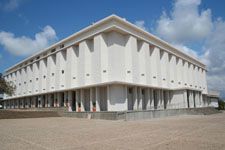 The Ghetto Fighter's Museum in Akko houses a wonderful archival repository and a museum to the victims of the Holocaust that is undergoing renovations and updating of their material exhibits. The Archives Director, Yossi Shavit, was also anxious to know more about the rescue of Jewish refugees in The Philippines. I have promised to share my findings with him and to send copies of my archival materials to him. The Ghetto Fighter's Museum in Akko houses a wonderful archival repository and a museum to the victims of the Holocaust that is undergoing renovations and updating of their material exhibits. The Archives Director, Yossi Shavit, was also anxious to know more about the rescue of Jewish refugees in The Philippines. I have promised to share my findings with him and to send copies of my archival materials to him.
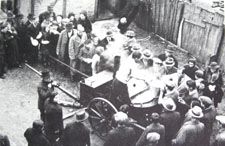 Through Yossi's help in searching the databases of his archives, I was able to find a collection of newspaper articles from U.S. presses concerning the Polenaktion and the deportation of Jews to Zbaszyn - an irony of primary research that yields newspaper articles from American papers about an incident in Europe that are being housed in Israel. Through Yossi's help in searching the databases of his archives, I was able to find a collection of newspaper articles from U.S. presses concerning the Polenaktion and the deportation of Jews to Zbaszyn - an irony of primary research that yields newspaper articles from American papers about an incident in Europe that are being housed in Israel.
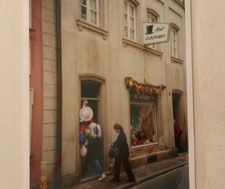 A highlight of the research trip to Israel was the invitation to celebrate Pesach with Naomi Leshem and her family in Tel Aviv. Naomi is the niece of Cantor Cysner, being the daughter of Berthold Cysner, Joseph's older brother, a Zionist who had immigrated to Israel in the early 1930s. This picture, taken from a family photo album at Naomi's house, recorded the visit of Sylvia Cysner to her hometown of Bamberg, Germany in 1999. It was a historic visit, as Sylvia had not been back to Bamberg since she fled after Kristallnacht in 1938. A highlight of the research trip to Israel was the invitation to celebrate Pesach with Naomi Leshem and her family in Tel Aviv. Naomi is the niece of Cantor Cysner, being the daughter of Berthold Cysner, Joseph's older brother, a Zionist who had immigrated to Israel in the early 1930s. This picture, taken from a family photo album at Naomi's house, recorded the visit of Sylvia Cysner to her hometown of Bamberg, Germany in 1999. It was a historic visit, as Sylvia had not been back to Bamberg since she fled after Kristallnacht in 1938.
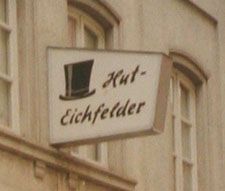 When I later visited Bamberg myself, in July 2006, I had all the images from the photo album with me on my laptop. As I did not have the street name with me, I viewed the pictures from Naomi's album, concentrating on this photo that told me the name of the business that was next door to Sylvia's prior residence. I stopped at a restaurant, asked for a phone book of Bamberg and looked up the address for "Hut Eichfelder." I was able to locate the street and exact building, strolling through Sylvia's childhood neighborhood. When I later visited Bamberg myself, in July 2006, I had all the images from the photo album with me on my laptop. As I did not have the street name with me, I viewed the pictures from Naomi's album, concentrating on this photo that told me the name of the business that was next door to Sylvia's prior residence. I stopped at a restaurant, asked for a phone book of Bamberg and looked up the address for "Hut Eichfelder." I was able to locate the street and exact building, strolling through Sylvia's childhood neighborhood.
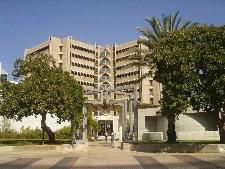 My research through Tel Aviv University is an example of the acquisition of materials occurring strictly through the miracle of today's New Media Communications. While in Warsaw in July 2006, I acquired bibliographic information from the Institute for Jewish History in Warsaw that directed me to find the 18th volume of the Gal-Ed Journal for an article on the Polish Press and the Zbaszyn Deportation. Internet searching told me that the journal was published by The Institute for the History of Polish Jewry at Tel Aviv University. While in Poland, I emailed Haim Cohen, the Managing Editor of the Gal-Ed, and told him of my desire in acquiring an article from his publication. He graciously scanned all 18 pages of the article, converted them into a .pdf file, attached it to an email, and sent the article to me via the internet. In this manner I was able to obtain an important item that I did not know about during my visit to Israel in April through the use of modern media in July. My research through Tel Aviv University is an example of the acquisition of materials occurring strictly through the miracle of today's New Media Communications. While in Warsaw in July 2006, I acquired bibliographic information from the Institute for Jewish History in Warsaw that directed me to find the 18th volume of the Gal-Ed Journal for an article on the Polish Press and the Zbaszyn Deportation. Internet searching told me that the journal was published by The Institute for the History of Polish Jewry at Tel Aviv University. While in Poland, I emailed Haim Cohen, the Managing Editor of the Gal-Ed, and told him of my desire in acquiring an article from his publication. He graciously scanned all 18 pages of the article, converted them into a .pdf file, attached it to an email, and sent the article to me via the internet. In this manner I was able to obtain an important item that I did not know about during my visit to Israel in April through the use of modern media in July.

I spent the month of June, 2006, on the East Coast of the U.S., staying with my good friend Michelle and her family in Chambersburg, Pennsylvania. From her home, I was able to travel to various locales on the Atlantic side of the country and access archives that I had not visited before and conduct oral history interviews with survivors of the Jewish Community in Manila. I made two separate trips to Washington D.C., spent a week in New York City, traveled to Boston for the AJL Convention, and stopped at Philadelphia to visit the Museum of the American Jewish Historical Society,
 My trips to Washington D.C. were for the sole purpose of researching in the archives and library of the United States Holocaust Memorial Museum. I was fortunate to find information on both the immigration of Jews to the Philippines and on the Polish border town of Zbaszyn. The archives of the USHMM allows researchers to make photocopies free of charge and this is the only archive in all my research that had such a policy. It was greatly appreciated!! My trips to Washington D.C. were for the sole purpose of researching in the archives and library of the United States Holocaust Memorial Museum. I was fortunate to find information on both the immigration of Jews to the Philippines and on the Polish border town of Zbaszyn. The archives of the USHMM allows researchers to make photocopies free of charge and this is the only archive in all my research that had such a policy. It was greatly appreciated!!
 While in Wash D.C., I had the opportunity to meet with Martin Meadows, a survivor of the Jewish Community in Manila, and also an internee at the University of Santo Tomas Internment Camp (STIC), set up by the Japanese for the incarceration of enemy alien civilians. Martin's family was American, his father a businessman in The Philippines before the war. He remembered well the rescue of the German refugee Jews, and Cantor Cysner. While in Wash D.C., I had the opportunity to meet with Martin Meadows, a survivor of the Jewish Community in Manila, and also an internee at the University of Santo Tomas Internment Camp (STIC), set up by the Japanese for the incarceration of enemy alien civilians. Martin's family was American, his father a businessman in The Philippines before the war. He remembered well the rescue of the German refugee Jews, and Cantor Cysner.

 Between my two visits to Washington D.C. I spent one week in New York City researching at two important locations - Between my two visits to Washington D.C. I spent one week in New York City researching at two important locations -
The Center for Jewish History and the American Jewish Joint Distribution Committee. At the JDC I was able to view microfilmed documents that contained important information on both the Zbaszyn deportation and the rescue in Manila, since the JDC had played an important roll in supplying relief to both communities. I ordered all the documents to be microfilmed and then shipped to me once I returned from Europe. Shortly after I returned home in August, I received 6 rolls of microfilm from the JDC archivist, Misha Mitsel. Vachashah!
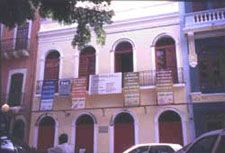 I spent several productive days of research at the Center for Jewish History in NYC, where the archives for several repositories share the same reading room (see artist rendering below). I was able to access several collections from the American Jewish Historical Society, the Leo Baeck Institute, and the YIVO Institute for Jewish Research. I shipped home 30 lbs. of photocopies before I left for Europe I spent several productive days of research at the Center for Jewish History in NYC, where the archives for several repositories share the same reading room (see artist rendering below). I was able to access several collections from the American Jewish Historical Society, the Leo Baeck Institute, and the YIVO Institute for Jewish Research. I shipped home 30 lbs. of photocopies before I left for Europe
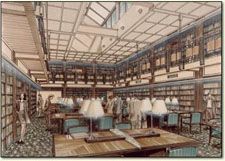 The security at the Center and the control of the documents was the best I have ever experienced. The archivists for the different repositories were very helpful and through their assistance I was able to find records from U.S. Military Chaplains whose names had been listed on photographs in the Cysner Collection in San Diego. The service jackets of these Chaplains are giving an entirely new perspective to post-war Manila. The security at the Center and the control of the documents was the best I have ever experienced. The archivists for the different repositories were very helpful and through their assistance I was able to find records from U.S. Military Chaplains whose names had been listed on photographs in the Cysner Collection in San Diego. The service jackets of these Chaplains are giving an entirely new perspective to post-war Manila.
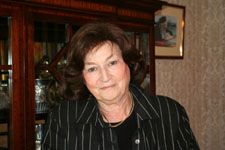 When I left NYC to attend the conference of American Jewish Libraries in Boston, I stopped in Lawrence, NY and met this wonderful lady, Lotte Holzer Bunim, and her husband, Rabbi Bunim. Lotte and her family were Jewish refugees rescued by the Frieder-McNutt rescue operation in Manila. We spent a wonderful time together and her memories as a youth during the circumstances of the diaspora of her family to The Philippines were enlivening for me, especially her memories of Cantor Cysner. When I left NYC to attend the conference of American Jewish Libraries in Boston, I stopped in Lawrence, NY and met this wonderful lady, Lotte Holzer Bunim, and her husband, Rabbi Bunim. Lotte and her family were Jewish refugees rescued by the Frieder-McNutt rescue operation in Manila. We spent a wonderful time together and her memories as a youth during the circumstances of the diaspora of her family to The Philippines were enlivening for me, especially her memories of Cantor Cysner.

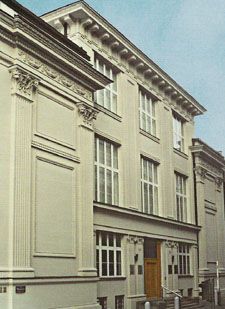 Michele and I left from JFK Airport July 2, 2006 for a whirlwind trip through Poland, The Czech Republic, Austria, and Germany. While in Warsaw, I had the opportunity to visit the Jewish Historical Institute, which is housed in the builidng of the former Main Judaic library of Warsaw. At one time it stood next to the Great Warsaw Synagogue on Tlomackie Street, which was destroyed by the invading Nazis. Having itself been looted by the German army, the structure was rebuilt in 1947 and from that time has been the seat of the Jewish Historical Institute. It is one of the few remaining traces of the most important Jewish cultural centers of the world. Michele and I left from JFK Airport July 2, 2006 for a whirlwind trip through Poland, The Czech Republic, Austria, and Germany. While in Warsaw, I had the opportunity to visit the Jewish Historical Institute, which is housed in the builidng of the former Main Judaic library of Warsaw. At one time it stood next to the Great Warsaw Synagogue on Tlomackie Street, which was destroyed by the invading Nazis. Having itself been looted by the German army, the structure was rebuilt in 1947 and from that time has been the seat of the Jewish Historical Institute. It is one of the few remaining traces of the most important Jewish cultural centers of the world.
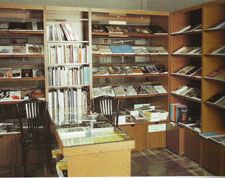 Even though previous emails to the Institute had yielded no archival contributions to my research, the librarians who were there on the day I visited helped me find two books in their bookstore, Preludium Zaglady by Tomaszewski and Noc krysztalowa i casus Herschela Grynszpana by Karol Jonca. Both these publications, in Polish, have chapters pertaining to the Polenaktion and the Zbaszyn internment. I was able to find a German translation of Tomaszewski's work. Even though previous emails to the Institute had yielded no archival contributions to my research, the librarians who were there on the day I visited helped me find two books in their bookstore, Preludium Zaglady by Tomaszewski and Noc krysztalowa i casus Herschela Grynszpana by Karol Jonca. Both these publications, in Polish, have chapters pertaining to the Polenaktion and the Zbaszyn internment. I was able to find a German translation of Tomaszewski's work.

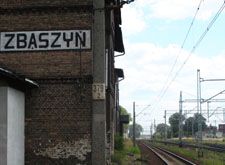 Actually traveling to and arriving in the obscure border town of Zbaszyn was an exciting excursion for me. I went with Zlotys, Dollars, and Euros in my pocket and my camera on my back, not knowing just exactly what I was going to do once I got there.When I successfully got off the puddle-jumper train from Poznan, I stood alone at the train depot, looking skyward and literally saying, "Well Joseph, I am here. Now what?" Actually traveling to and arriving in the obscure border town of Zbaszyn was an exciting excursion for me. I went with Zlotys, Dollars, and Euros in my pocket and my camera on my back, not knowing just exactly what I was going to do once I got there.When I successfully got off the puddle-jumper train from Poznan, I stood alone at the train depot, looking skyward and literally saying, "Well Joseph, I am here. Now what?"
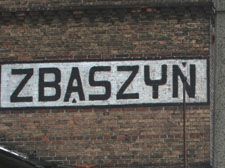 After walking around the immediate area of the Bahnhof and taking many pictures, I noticed a single taxi-cab parked on the other side of the depot. He spoke neither English nor German, and I spoke no Polish, but by showing him a photograph of the city's town square I got off the internet and making driving motions with my hands, he nodded his pleasure in driving me to the center of town and then around Zbaszyn for awhile. After walking around the immediate area of the Bahnhof and taking many pictures, I noticed a single taxi-cab parked on the other side of the depot. He spoke neither English nor German, and I spoke no Polish, but by showing him a photograph of the city's town square I got off the internet and making driving motions with my hands, he nodded his pleasure in driving me to the center of town and then around Zbaszyn for awhile.
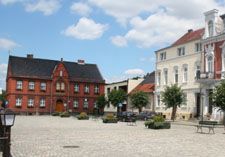 He drove me to the square in the photograph and led me around the city as I took pictures of places he thought I would be interested in, and I was happy to oblige. After walking around for a while, he found an older woman in town who had lived in Thuringen during WWII and her German and my German understood each other very well! I was able to tell her what I wanted to see in Zbaszyn and she then told my taxi driver. He drove me to the square in the photograph and led me around the city as I took pictures of places he thought I would be interested in, and I was happy to oblige. After walking around for a while, he found an older woman in town who had lived in Thuringen during WWII and her German and my German understood each other very well! I was able to tell her what I wanted to see in Zbaszyn and she then told my taxi driver.
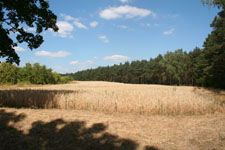 I was most anxious to see the area of the border, where Cantor Cysner recalled very graphically in his memoir the episode of the thousands of refugees being dumped at the border and forcibly driven on foot into Nomansland at the point of Nazi bayonets. He described a scene of terrifying chaos as Polish border guards threatened to shoot the mass of homeless intruders as they tried to cross the border into Poland. I was most anxious to see the area of the border, where Cantor Cysner recalled very graphically in his memoir the episode of the thousands of refugees being dumped at the border and forcibly driven on foot into Nomansland at the point of Nazi bayonets. He described a scene of terrifying chaos as Polish border guards threatened to shoot the mass of homeless intruders as they tried to cross the border into Poland.
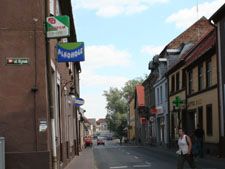 Polish officials relented and the refugees were allowed to stay in Zbaszyn, a town of only about 5,000 who had nearly 10,000 refugees deported en masse to their town. Refugees were scattered around town, encamped at the Bahnhof, sleeping in the stairwells, in barns, and some were able to find lodging with citizens of Zbaszyn, as did Cantor Cysner. When I had returned to Berlin, I discovered that I had a document that bore Cantor Cysner's address in Zbaszyn and I was so upset that I had not seen the document and noticed the address before I left for Zbaszyn. I knew that I would probably never return to Zbaszyn to capture the picture. Polish officials relented and the refugees were allowed to stay in Zbaszyn, a town of only about 5,000 who had nearly 10,000 refugees deported en masse to their town. Refugees were scattered around town, encamped at the Bahnhof, sleeping in the stairwells, in barns, and some were able to find lodging with citizens of Zbaszyn, as did Cantor Cysner. When I had returned to Berlin, I discovered that I had a document that bore Cantor Cysner's address in Zbaszyn and I was so upset that I had not seen the document and noticed the address before I left for Zbaszyn. I knew that I would probably never return to Zbaszyn to capture the picture.
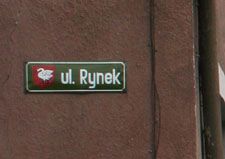 I then recalled that I had taken pictures of streets at random in Zbaszyn and wondered if I had taken a picture of Cantor Cysner's address and much to my delight and amazement, I HAD taken a picture with a street sign in the picture, and as I enlarged it I saw the name of the street where Cantor Cysner had lived - Rynek. I still can't believe how amazing this was. When I had asked Joseph for help in knowing where to go, I had not imagined that it would be so literal. I then recalled that I had taken pictures of streets at random in Zbaszyn and wondered if I had taken a picture of Cantor Cysner's address and much to my delight and amazement, I HAD taken a picture with a street sign in the picture, and as I enlarged it I saw the name of the street where Cantor Cysner had lived - Rynek. I still can't believe how amazing this was. When I had asked Joseph for help in knowing where to go, I had not imagined that it would be so literal.

After spending a couple of weeks touring Holocaust sites in Poland, the Czech Republic, Austria and Germany, my arrival in Berlin marked the beginning of an intensive two weeks of archival research in Berlin, and then in Hamburg, Germany.
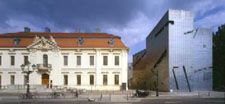 The Jewish Museum in Berlin is actually two buildings, as you see here. One is the old. classic building that houses the archives, library, reading room, offices, etc., and the other is the new famous structure designed by David Libeskind that is tall, reflective steel that looks like a zigzag scar, or tear across the site. I talk more about its design in my website section on Holocaust sites. The Jewish Museum in Berlin is actually two buildings, as you see here. One is the old. classic building that houses the archives, library, reading room, offices, etc., and the other is the new famous structure designed by David Libeskind that is tall, reflective steel that looks like a zigzag scar, or tear across the site. I talk more about its design in my website section on Holocaust sites.
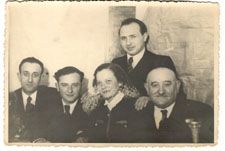 My research in the archives of the Jewish Museum in Berlin yielded some interesting items on the topic of the Polenaktion and the Zbaszyn internment. This photo to the left is from the collection of Cantor Cysner in the Archives of the Jewish Historical Society of San Diego. All persons in the photo are identified except the gentleman on the far left. As I was searching in the documents at the Jewish museum, I came across this item. . . My research in the archives of the Jewish Museum in Berlin yielded some interesting items on the topic of the Polenaktion and the Zbaszyn internment. This photo to the left is from the collection of Cantor Cysner in the Archives of the Jewish Historical Society of San Diego. All persons in the photo are identified except the gentleman on the far left. As I was searching in the documents at the Jewish museum, I came across this item. . .
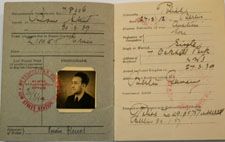 . . . the Certificate of Registration for Rabbi Erwin Zimet among other items in a collection of his papers. I knew immediately when I saw his face that I had seen him before and it wasn't until another paper is his collection revealed that he was the Rabbi who married the Ehepaar in the picture from Cantor Cysner's Collection. Rabbi Zimet's papers have the couple's marriage license. . . . the Certificate of Registration for Rabbi Erwin Zimet among other items in a collection of his papers. I knew immediately when I saw his face that I had seen him before and it wasn't until another paper is his collection revealed that he was the Rabbi who married the Ehepaar in the picture from Cantor Cysner's Collection. Rabbi Zimet's papers have the couple's marriage license.
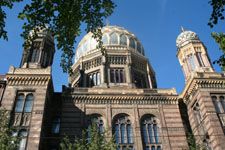 The magnificent Neue Synagogue in Berlin completed construction in 1866 and was at the time the largest synagogue in the world. It was desecrated by the Nazis during Kristallnacht Nov. 9 - 10, 1938 and was then destroyed in 1943 by Allied bombing. The building was finally demolished in 1958. With the fall of the Berlin Wall in 1988, reconstruction started and the restored Neue Synagogue was completed in May 1995. The magnificent Neue Synagogue in Berlin completed construction in 1866 and was at the time the largest synagogue in the world. It was desecrated by the Nazis during Kristallnacht Nov. 9 - 10, 1938 and was then destroyed in 1943 by Allied bombing. The building was finally demolished in 1958. With the fall of the Berlin Wall in 1988, reconstruction started and the restored Neue Synagogue was completed in May 1995.
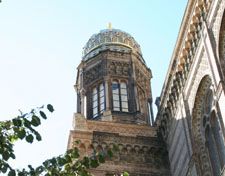 Today it houses the Centrum Judaicum and is an important center for Jewish life in Berlin. I had the opportunity to meet with Director Hermann Simon on two occasions and while the only documents the Centrum had for me pertained to Henerietta Cysner, Joseph's sister who immigrated to England from Berlin, Herr Simon was very interested in my research and was most helpful in suggesting other avenues of research. Today it houses the Centrum Judaicum and is an important center for Jewish life in Berlin. I had the opportunity to meet with Director Hermann Simon on two occasions and while the only documents the Centrum had for me pertained to Henerietta Cysner, Joseph's sister who immigrated to England from Berlin, Herr Simon was very interested in my research and was most helpful in suggesting other avenues of research.

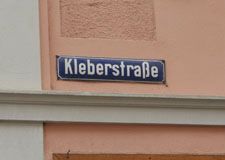 My intent in visiting Bamberg was to find the childhood homes and neighborhoods of Joseph Cysner and his wife, then Sylvia Nagler. I recounted above about my visit with Naomi Leshem in Tel Aviv, Israel and how her family photo album had helped me find Sylvia's home on Kleberstrasse in Bamberg. I spent a wonderful afternoon photo documenting every area of the town where my search for their addresses took me. My intent in visiting Bamberg was to find the childhood homes and neighborhoods of Joseph Cysner and his wife, then Sylvia Nagler. I recounted above about my visit with Naomi Leshem in Tel Aviv, Israel and how her family photo album had helped me find Sylvia's home on Kleberstrasse in Bamberg. I spent a wonderful afternoon photo documenting every area of the town where my search for their addresses took me.
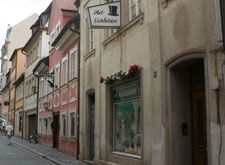 I took several pictures of this building with the Hut Eichfelder sign, which was the important landmark that allowed me to find Sylvia's childhood address. This picture is actually looking at the shop sign from the opposite direction of Naomi's picture. Sylvia's door is just to the left of the sign. It appeared when I was there that the door had a gate across it and it was doubtful that anyone lived there. I took several pictures of this building with the Hut Eichfelder sign, which was the important landmark that allowed me to find Sylvia's childhood address. This picture is actually looking at the shop sign from the opposite direction of Naomi's picture. Sylvia's door is just to the left of the sign. It appeared when I was there that the door had a gate across it and it was doubtful that anyone lived there.
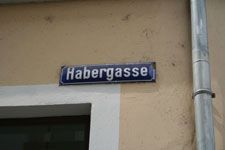 Finding Cantor Cysner's address was never a problem because I had his place of birth on a copy of his birth certificate that I had brought with me. Once I arrived at the Bahnhof, I purchased a detailed street map of Bamberg and Cantor Cysner's address was actually the first destination I found. Finding Cantor Cysner's address was never a problem because I had his place of birth on a copy of his birth certificate that I had brought with me. Once I arrived at the Bahnhof, I purchased a detailed street map of Bamberg and Cantor Cysner's address was actually the first destination I found.
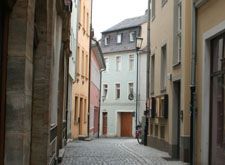 Habergasse Strasse wound around in several sections and as I came down this narrow portion of Habergasse, I was not yet aware that the building directly in front of me was the building with #8, whose door was just out of sight of my lens, the blue door in the bottom picture. Habergasse Strasse wound around in several sections and as I came down this narrow portion of Habergasse, I was not yet aware that the building directly in front of me was the building with #8, whose door was just out of sight of my lens, the blue door in the bottom picture.
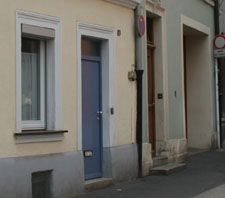 Cantor Cysner lived at #8 Habergasse Strasse in Bamberg. I am sorry to say that I was not bold enough that day to ring the bell and ask the current tenant if I could come into his home and look around, but I did photograph his name and profession on the label of the doorbell and I thought I might write to him someday and ask . . . ask what, I have no idea!! Perhaps to inquire how long he has resided there and if his family had any history from the war years that he would like to share with me. Cantor Cysner lived at #8 Habergasse Strasse in Bamberg. I am sorry to say that I was not bold enough that day to ring the bell and ask the current tenant if I could come into his home and look around, but I did photograph his name and profession on the label of the doorbell and I thought I might write to him someday and ask . . . ask what, I have no idea!! Perhaps to inquire how long he has resided there and if his family had any history from the war years that he would like to share with me.

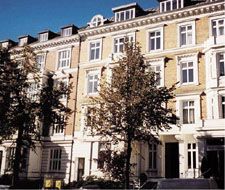 By far, I had more success with my research in Hamburg than any other location in Europe when it came to finding primary documents regarding the Polenaktion and the Zbaszyn internment. At the Institute for the History of German Jews, (Institute für die Geschichte der Deutschen Juden in Hamburg), Dr. Beate Meyer had prepared numerous items for me to review. The Institute had written numerous pieces over the years about the deportations from Hamburg, as the Polenaktion had a significant impact on Hamburg. By far, I had more success with my research in Hamburg than any other location in Europe when it came to finding primary documents regarding the Polenaktion and the Zbaszyn internment. At the Institute for the History of German Jews, (Institute für die Geschichte der Deutschen Juden in Hamburg), Dr. Beate Meyer had prepared numerous items for me to review. The Institute had written numerous pieces over the years about the deportations from Hamburg, as the Polenaktion had a significant impact on Hamburg.
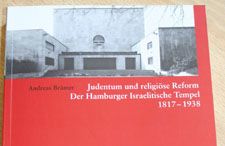 One of the many publications that Dr. Beate Meyer had made available to me was this monograph by one of their researchers about the Tempel Verband, the Reform Synagogue where Cantor Cysner served when he was arrested and deported to Poland, never to return to his beloved synagogue again. In the excerpt below, taken from this book, Cantor Cysner is named. One of the many publications that Dr. Beate Meyer had made available to me was this monograph by one of their researchers about the Tempel Verband, the Reform Synagogue where Cantor Cysner served when he was arrested and deported to Poland, never to return to his beloved synagogue again. In the excerpt below, taken from this book, Cantor Cysner is named.
 In a footnote to this mention of Cantor Cysner in the history of Tempel Verband, the author says that Canton Cysner left the temple in 1938 and went to live somewhere else. It is clear that this history had not recorded that Cantor Cysner had been arrested by the Gestapo and deported to Zbaszyn. Many victims were no doubt lost to the Zbaszyn deportation, never heard of again and their final fate remains unknown. In a footnote to this mention of Cantor Cysner in the history of Tempel Verband, the author says that Canton Cysner left the temple in 1938 and went to live somewhere else. It is clear that this history had not recorded that Cantor Cysner had been arrested by the Gestapo and deported to Zbaszyn. Many victims were no doubt lost to the Zbaszyn deportation, never heard of again and their final fate remains unknown.
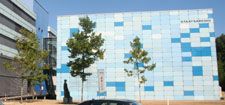 Dr. Meyer had referred me to Jürgen Sielemann at the Staatsarchiv in Hamburg, who very graciously agreed to meet with me on very short notice. As I had done at all the other place of research I had visited, I left a CD of my pre-dissertation paper with him, and in return he gifted me his new publication, A Book of Remembrance for the deceased Jewish citizens of Hamburg in the Holocaust. This was certainly unexpected and very appreciated. Dr. Meyer had referred me to Jürgen Sielemann at the Staatsarchiv in Hamburg, who very graciously agreed to meet with me on very short notice. As I had done at all the other place of research I had visited, I left a CD of my pre-dissertation paper with him, and in return he gifted me his new publication, A Book of Remembrance for the deceased Jewish citizens of Hamburg in the Holocaust. This was certainly unexpected and very appreciated.
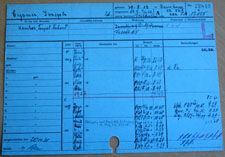 One of the greatest finds at the Staatsarchiv in Hamburg, was this one, small. blue tax record that bore the actual address of Cantor Cysner on Isestrasse. Apparently Joseph had changed building numbers on Isestrasse at some point early in his residency, because the first address I had for him could not be confirmed by Dr. Meyer at the Institute. Now with this document, Cantor Cysner's address in Hamburg has been confirmed. One of the greatest finds at the Staatsarchiv in Hamburg, was this one, small. blue tax record that bore the actual address of Cantor Cysner on Isestrasse. Apparently Joseph had changed building numbers on Isestrasse at some point early in his residency, because the first address I had for him could not be confirmed by Dr. Meyer at the Institute. Now with this document, Cantor Cysner's address in Hamburg has been confirmed.
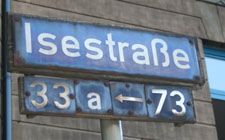 Once I had his correct address, I purchased a detailed street map of Hamburg and found Isestrasse. At first, I only found those properties whose house numbers were above 100. I could not see where the lower numbers resumed.While seated at a restaurant on the corner where the higher numbers ended, I glanced across the street and saw an avenue hidden by low hanging trees and the overhead rails. . . . Once I had his correct address, I purchased a detailed street map of Hamburg and found Isestrasse. At first, I only found those properties whose house numbers were above 100. I could not see where the lower numbers resumed.While seated at a restaurant on the corner where the higher numbers ended, I glanced across the street and saw an avenue hidden by low hanging trees and the overhead rails. . . .
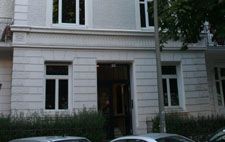 . . . Once I crossed over the intersection I found an entire neighborhood hidden from view. I walked the street and took many pictures of the area, including several of Cantor Cysner's address at #65. Now with verifiable documentation of his address, his name and biographical information can be submitted to the Stolpersteine Program that commemorates victims of the Holocaust. . . . Once I crossed over the intersection I found an entire neighborhood hidden from view. I walked the street and took many pictures of the area, including several of Cantor Cysner's address at #65. Now with verifiable documentation of his address, his name and biographical information can be submitted to the Stolpersteine Program that commemorates victims of the Holocaust.
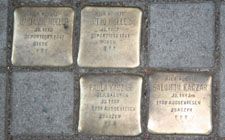 The Stolpersteine are stone-shaped bronze plaques that bear the name and vital dates of victims of the Holocaust. These stones are set in the walkways of addresses where the known victims either lived or worked. Thousands of these Stolpersteine have been set into the sidewalks in Hamburg, Berlin, Bonn, Bremen, Essen, Frankfurt, just to name a few of the German cities embracing this program. The Stolpersteine are stone-shaped bronze plaques that bear the name and vital dates of victims of the Holocaust. These stones are set in the walkways of addresses where the known victims either lived or worked. Thousands of these Stolpersteine have been set into the sidewalks in Hamburg, Berlin, Bonn, Bremen, Essen, Frankfurt, just to name a few of the German cities embracing this program.
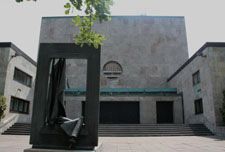 Documents confirm that Cantor Cysner worked at the Tempel Verband Reform Synagogue in Hamburg that was the only synagogue in Hamburg NOT destroyed on Kristallnacht.This early liberal Jewish community had been the pioneers of Reform Judaism. Today it houses the offices of a local radio station. The sculpture shows a Torah Ark with the desecrated Torah Scrolls spilling out - an appropriate epitaph. Documents confirm that Cantor Cysner worked at the Tempel Verband Reform Synagogue in Hamburg that was the only synagogue in Hamburg NOT destroyed on Kristallnacht.This early liberal Jewish community had been the pioneers of Reform Judaism. Today it houses the offices of a local radio station. The sculpture shows a Torah Ark with the desecrated Torah Scrolls spilling out - an appropriate epitaph.
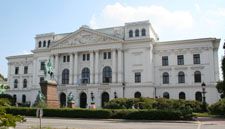 Cantor Cysner's memoir of his deportation experiences tells about the masses of refugees that were assembled at the Altona Bahnhof and who were packed into train cars and deported en masse to the Polish border. The Altona Rathaus offices now occupy the historic structure of the old Altona Bahnhof. Cantor Cysner's memoir of his deportation experiences tells about the masses of refugees that were assembled at the Altona Bahnhof and who were packed into train cars and deported en masse to the Polish border. The Altona Rathaus offices now occupy the historic structure of the old Altona Bahnhof.
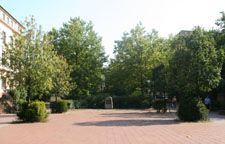 Prior study into the area of Altona revealed to me that a memorial had been built at a much earlier time to the victims of the Polenaktion in Hamburg. As I walked the Altona Museum District, a park area between the new Altona Bahnhof and the Rathaus, I stumbled upon the memorial site, which was hidden behind surrounding trees in a rather obscure area. The small stone in the near center of the picture is the Polenaktion Memorial Stele. Prior study into the area of Altona revealed to me that a memorial had been built at a much earlier time to the victims of the Polenaktion in Hamburg. As I walked the Altona Museum District, a park area between the new Altona Bahnhof and the Rathaus, I stumbled upon the memorial site, which was hidden behind surrounding trees in a rather obscure area. The small stone in the near center of the picture is the Polenaktion Memorial Stele.
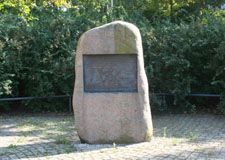 A translation of the plaque reads: "From here, at the Altoner Bahnhof, more than 800 Polish Jews from Hamburg - men, women and children - were expelled by the Gestapo to the Polish Border. On the same day, they were arrested in the early morning and brought to a common jail. From there they were transported by trucks to the Altoner Bahnhof. By special trains in the same evening, they had to abandon Hamburg. Many of them later perished." erected 1987. A translation of the plaque reads: "From here, at the Altoner Bahnhof, more than 800 Polish Jews from Hamburg - men, women and children - were expelled by the Gestapo to the Polish Border. On the same day, they were arrested in the early morning and brought to a common jail. From there they were transported by trucks to the Altoner Bahnhof. By special trains in the same evening, they had to abandon Hamburg. Many of them later perished." erected 1987.
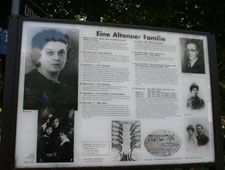 As I continued to walk the area, I came across exhibit signs, like this one pictured here, that honored Jewish citizens of Hamburg who had contributed to the cultural, economic, and political life of the Altona district. The plaques contained historical information with copies of pictures and documents, all set behind a protective coating. I was intrigued as to what organization had sponsored the public display of Hamburg Jewish history. . . . As I continued to walk the area, I came across exhibit signs, like this one pictured here, that honored Jewish citizens of Hamburg who had contributed to the cultural, economic, and political life of the Altona district. The plaques contained historical information with copies of pictures and documents, all set behind a protective coating. I was intrigued as to what organization had sponsored the public display of Hamburg Jewish history. . . .
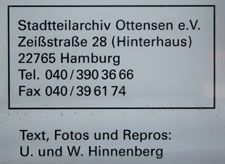 . . . Luckily for me, the name of the organization was printed on the lower edge of the plaque, Stadtteilarchiv Ottensen. I made inquiries as to where Zeissstrasse was and determined to return to the area and find the organization. When I did so, the facilitiy was closed and even though I waited, no one returned from lunch as their posted hours had indicated. Because I had found this small, local archive late in my trip, I did not have time to return again to research at their site. . . . Luckily for me, the name of the organization was printed on the lower edge of the plaque, Stadtteilarchiv Ottensen. I made inquiries as to where Zeissstrasse was and determined to return to the area and find the organization. When I did so, the facilitiy was closed and even though I waited, no one returned from lunch as their posted hours had indicated. Because I had found this small, local archive late in my trip, I did not have time to return again to research at their site.
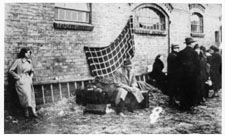 I had written down their email address, which was on their door. Correspondence with their archivst, Gaby von Malottki, yielded a true treasure trove of documents pertaining to the Polenaktion, along with this photograph of Zbaszyn deportees lingering around the Bahnhof in Zbaszyn. I recognized the architecture from my visit to Zbaszyn. I had written down their email address, which was on their door. Correspondence with their archivst, Gaby von Malottki, yielded a true treasure trove of documents pertaining to the Polenaktion, along with this photograph of Zbaszyn deportees lingering around the Bahnhof in Zbaszyn. I recognized the architecture from my visit to Zbaszyn.
Upon my return home from my two month long research trip on the East Coast of the U.S. and Europe, I began organizing all the information from the contacts I had made so I could follow through with those repositories that still had information to send. Since then, I have discovered other places, such as the University of Hamburg where oral histories contain testimonies of Zbaszyn experiences, that I will soon need to visit. So stay posted, I am not down yet, Folks!!

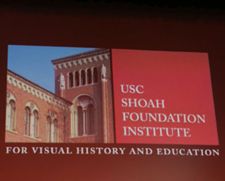 While filming Schindler's List in Poland, Steven Spielberg was approached by many victims of the Holocaust, whose testimonies he was recording for his film, expressing a need to share more of their survivor experiences with him. Spielberg relates how their witnessing moved him to begin the "Survivors of the Shoah Visual History Foundation" whose mission it was to record the testimonies of the witnesses of the Holocaust before their stories were lost in death forever. While filming Schindler's List in Poland, Steven Spielberg was approached by many victims of the Holocaust, whose testimonies he was recording for his film, expressing a need to share more of their survivor experiences with him. Spielberg relates how their witnessing moved him to begin the "Survivors of the Shoah Visual History Foundation" whose mission it was to record the testimonies of the witnesses of the Holocaust before their stories were lost in death forever.
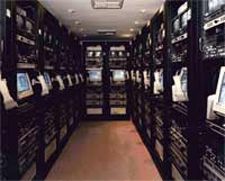 From 1994 to 1999, over 52,000 testimonies were collected, resulting in the world's largest visual history archive with over 120,000 hours of video testimonies from 56 different countries, in 32 different languages. More than 90 percent of the testimonies are from Jewish Holocaust survivors; however, the archive also contains interviews with other survivors, including Jehovah's Witnesses, Sinti and Roma, homosexuals, political prisoners, and survivors of eugenics policies. In addition, the Shoah Foundation has interviewed rescuers and aid providers, liberators, and war crimes trials participants. From 1994 to 1999, over 52,000 testimonies were collected, resulting in the world's largest visual history archive with over 120,000 hours of video testimonies from 56 different countries, in 32 different languages. More than 90 percent of the testimonies are from Jewish Holocaust survivors; however, the archive also contains interviews with other survivors, including Jehovah's Witnesses, Sinti and Roma, homosexuals, political prisoners, and survivors of eugenics policies. In addition, the Shoah Foundation has interviewed rescuers and aid providers, liberators, and war crimes trials participants.
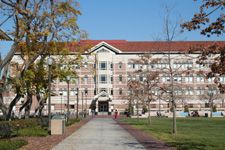 The testimonies can be viewed at the "USC Shoah Foundation Institute for Visual History and Education" in the Leavey Library on the campus of USC in Los Angeles, CA. As I was soon leaving for The Philippines on another research trip, I accessed several testimonies of survivors from Manila, who had been rescued by the Jewish Community in Manila and who had survived the destruction of the community during the liberation. The testimonies can be viewed at the "USC Shoah Foundation Institute for Visual History and Education" in the Leavey Library on the campus of USC in Los Angeles, CA. As I was soon leaving for The Philippines on another research trip, I accessed several testimonies of survivors from Manila, who had been rescued by the Jewish Community in Manila and who had survived the destruction of the community during the liberation.
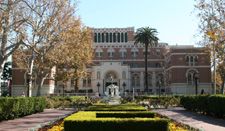 Offices for administrators of the Shoah Foundation are also in the Doheny Library on USC Campus, opposite the huge courtyard from the Leavey Library. I will be visiting the Shoah Foundation again to view testimonies of survivors and witnesses of the Polenaktion and the Zbaszyn Deportations. Offices for administrators of the Shoah Foundation are also in the Doheny Library on USC Campus, opposite the huge courtyard from the Leavey Library. I will be visiting the Shoah Foundation again to view testimonies of survivors and witnesses of the Polenaktion and the Zbaszyn Deportations.

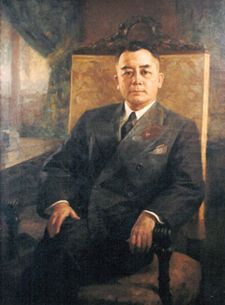 Towards the end of 2006, as I was conducting internet searches on Philippine history, I discovered an important collection housed on the campus of the University of The Philippines - The Jorge B. Vargas Collection. Either I had forgotten of its existence when I was in the Philippines nearly a year before, or I had never as yet discovered it. In either case, I knew I was going to need to go to the Philippines again, and as the only good time to go was in January or February, I hurriedly arranged for my return to The Philippines in February, 2007. Rather than staying in Manila, I booked accommodations in Quezon City in order to shorten the distance for the taxi trips to the University. Towards the end of 2006, as I was conducting internet searches on Philippine history, I discovered an important collection housed on the campus of the University of The Philippines - The Jorge B. Vargas Collection. Either I had forgotten of its existence when I was in the Philippines nearly a year before, or I had never as yet discovered it. In either case, I knew I was going to need to go to the Philippines again, and as the only good time to go was in January or February, I hurriedly arranged for my return to The Philippines in February, 2007. Rather than staying in Manila, I booked accommodations in Quezon City in order to shorten the distance for the taxi trips to the University.
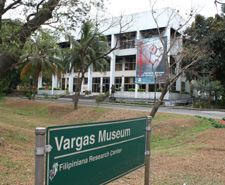 Jorge B. Vargas was the country's first Executive Secretary, serving in this position during the Commonwealth period under President Quezon. He was also the Mayor of Manila during the years of the Japanese occupation. On March 1, 1978, Vargas bequeathed his collection of art, stamps and coins, his library, personal papers and memorabilia to his Alma Mater, the University of the Philippines, all now housed in the Jorge B. Vargas Museum and Filipiniana Research Center on the campus of UP. Jorge B. Vargas was the country's first Executive Secretary, serving in this position during the Commonwealth period under President Quezon. He was also the Mayor of Manila during the years of the Japanese occupation. On March 1, 1978, Vargas bequeathed his collection of art, stamps and coins, his library, personal papers and memorabilia to his Alma Mater, the University of the Philippines, all now housed in the Jorge B. Vargas Museum and Filipiniana Research Center on the campus of UP.
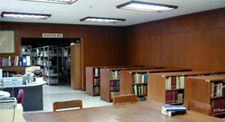 His years as Executive Secretary and Mayor of Manila are documented in over 100 scrapbooks of materials such as newspaper clippings, personal correspondence, invitations, photographs, along with published volumes of official documents. I spent nearly a full two weeks in this room examining this collection and recording the book and page numbers of my finds for a photocopy order of over 100 selected items. I do not imagine that this is the last trip I will make to The Philippines in my academic career. His years as Executive Secretary and Mayor of Manila are documented in over 100 scrapbooks of materials such as newspaper clippings, personal correspondence, invitations, photographs, along with published volumes of official documents. I spent nearly a full two weeks in this room examining this collection and recording the book and page numbers of my finds for a photocopy order of over 100 selected items. I do not imagine that this is the last trip I will make to The Philippines in my academic career.

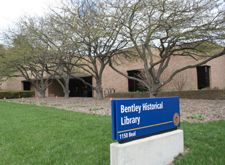 Perhaps the largest collection of primary documents on the history of the American Era in The Philippines is housed at the University of Michigan in the Bentley Historical Library - The American Philippines Relations Collection. Over the past 100 years or more, a large number of University of Michigan faculty and alumni and other citizens of Michigan have played a decisive role in shaping relations between the United States and the Philippines. Perhaps the largest collection of primary documents on the history of the American Era in The Philippines is housed at the University of Michigan in the Bentley Historical Library - The American Philippines Relations Collection. Over the past 100 years or more, a large number of University of Michigan faculty and alumni and other citizens of Michigan have played a decisive role in shaping relations between the United States and the Philippines.
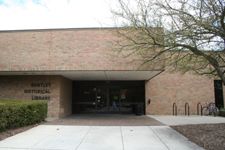 Close to 200 collections document 6 periods of Philippine history: Spanish Period up to 1898; Spanish-American War, 1898; Philippine-American War, 1899-1902; American Period, 1898-1946; WWII, 1941-1945; and Philippine Independence, 1946-Present. The period of time for my research deals specifically with the years of the Philippine Commonwealth, 1936-1946. Close to 200 collections document 6 periods of Philippine history: Spanish Period up to 1898; Spanish-American War, 1898; Philippine-American War, 1899-1902; American Period, 1898-1946; WWII, 1941-1945; and Philippine Independence, 1946-Present. The period of time for my research deals specifically with the years of the Philippine Commonwealth, 1936-1946.
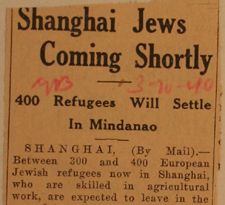 The collection that commanded my complete attention when I was there was the Joseph Ralston Hayden Collection. Hayden had scanned, clipped, and indexed Philippine newspapers for a decade. He had made use of fugitive publications and of Philippine periodicals. Some Philippine documents that have been printed are curiously rare; others have only been mimeographed; others exist only in typescript. This article from the Manila Bulletin of 1940 discusses bringing Jews from Shanghai to begin the mass resettlement plans on the Island of Mindanao. The collection that commanded my complete attention when I was there was the Joseph Ralston Hayden Collection. Hayden had scanned, clipped, and indexed Philippine newspapers for a decade. He had made use of fugitive publications and of Philippine periodicals. Some Philippine documents that have been printed are curiously rare; others have only been mimeographed; others exist only in typescript. This article from the Manila Bulletin of 1940 discusses bringing Jews from Shanghai to begin the mass resettlement plans on the Island of Mindanao.

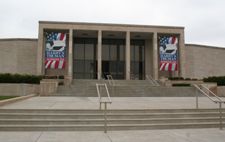 The Harry S. Truman Presidential Library and Museum is located in Independence, Missouri. While the driving approach to the Museum is rather spectacular, with a sweeping entrance to a beautifully situated facility set on a knoll, one has to drive around to the back to find the archives. Isn't that always the case. The Harry S. Truman Presidential Library and Museum is located in Independence, Missouri. While the driving approach to the Museum is rather spectacular, with a sweeping entrance to a beautifully situated facility set on a knoll, one has to drive around to the back to find the archives. Isn't that always the case.
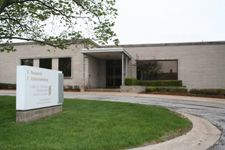 The time I spent at the Truman Library was some of the most stimulating research I have ever done. I thought the staff were extremely helpful and pleasant. I enjoyed the company of other researchers, especially, as we all spent an entire week together and became interested in what each other was researching. I was happy that they allowed me to set up my digital camera and to photograph my finds. The time I spent at the Truman Library was some of the most stimulating research I have ever done. I thought the staff were extremely helpful and pleasant. I enjoyed the company of other researchers, especially, as we all spent an entire week together and became interested in what each other was researching. I was happy that they allowed me to set up my digital camera and to photograph my finds.
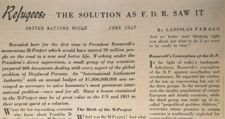 Of the many collections I accessed, the papers of Myron C. Taylor held the biggest surprise for me. Here was documentation on a top secret project of FDR's called The "M" Project, which stood for "migration." FDR had personally organized a committee of top U.S. scientists to study and formulate a massive post-war refugee resettlement plan with multiple relocation sites in consideration throughout the world. Over 600 documents were generated. Those are housed at the FDR Library, which I know I now have to visit. Of the many collections I accessed, the papers of Myron C. Taylor held the biggest surprise for me. Here was documentation on a top secret project of FDR's called The "M" Project, which stood for "migration." FDR had personally organized a committee of top U.S. scientists to study and formulate a massive post-war refugee resettlement plan with multiple relocation sites in consideration throughout the world. Over 600 documents were generated. Those are housed at the FDR Library, which I know I now have to visit.

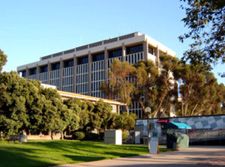 The Davidson Library Special Collections at the University of California, Santa Barbara has a rather unique photographic collection. The Jewish Diaspora News Collection houses 111 original press photographs, circa 1934 to 1962, depicting Jewish expulsions during the Nazi Era and establishment of the State of Israel. Also housed there are scrapbooks of American GIs who were stationed in The Philippines before and after the war. The Davidson Library Special Collections at the University of California, Santa Barbara has a rather unique photographic collection. The Jewish Diaspora News Collection houses 111 original press photographs, circa 1934 to 1962, depicting Jewish expulsions during the Nazi Era and establishment of the State of Israel. Also housed there are scrapbooks of American GIs who were stationed in The Philippines before and after the war.
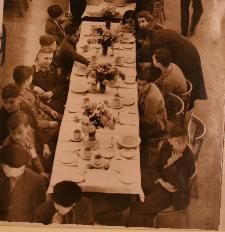 While I knew it would be a rare chance if the Jewish Diaspora News Photographic Collection had any photos of the Zbaszyn Deportations, I was surprised to see some rare footage of refugee children leaving Europe on the Kindertransports of 1939. My dissertation relates the testimonies of Zbaszyn survivors who had escaped via Kindertransports of this very same time period. The plight of the children in the Zbaszyn Deportations, which captured over 700 children in the mass expulsion and left them homeless and sometimes orphaned was one of the main catalysts for the mass transport of Jewish children to England. While I knew it would be a rare chance if the Jewish Diaspora News Photographic Collection had any photos of the Zbaszyn Deportations, I was surprised to see some rare footage of refugee children leaving Europe on the Kindertransports of 1939. My dissertation relates the testimonies of Zbaszyn survivors who had escaped via Kindertransports of this very same time period. The plight of the children in the Zbaszyn Deportations, which captured over 700 children in the mass expulsion and left them homeless and sometimes orphaned was one of the main catalysts for the mass transport of Jewish children to England.

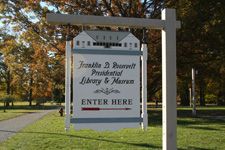 The Franklin D. Roosevelt Presidential Library and Museum is situated in a beautiful park just off the main road in Hyde Park, New York. I enjoyed walking to the library every morning from my motel in the bright sunlight, seeing the vibrant Fall colors of the autumn leaves on the tree-lined paths leading to the museum. I joked with the other researchers that we had these colors in California too, we called it "F I R E." The Franklin D. Roosevelt Presidential Library and Museum is situated in a beautiful park just off the main road in Hyde Park, New York. I enjoyed walking to the library every morning from my motel in the bright sunlight, seeing the vibrant Fall colors of the autumn leaves on the tree-lined paths leading to the museum. I joked with the other researchers that we had these colors in California too, we called it "F I R E."
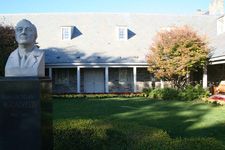 I had determined that I would visit the FDR Library while I was researching in the Truman Library in March. While I was particularly interested in papers of individuals who had served in the FDR Administration who had dealt with immigration issues, such as Myron C. Taylor of the Evian Conference, I was particularly intrigued with the collection of Ernest Cuneo, 1926-1988. Among other things, he was an intelligence liaison . . . I had determined that I would visit the FDR Library while I was researching in the Truman Library in March. While I was particularly interested in papers of individuals who had served in the FDR Administration who had dealt with immigration issues, such as Myron C. Taylor of the Evian Conference, I was particularly intrigued with the collection of Ernest Cuneo, 1926-1988. Among other things, he was an intelligence liaison . . .
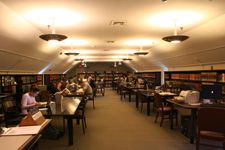 . . .between the OSS, British Intelligence, the FBI, the Dept.of State, and the White House. That is when he met and became good friend with Ian Fleming, contributing plot directions to Fleming's James Bond novels Goldfinger and Thunderball. In Cuneo's papers are extensive articles he wrote about the political history of the Philippines in the 1920, 30s, 40s, and 50s - a wonderful and rare find. . . .between the OSS, British Intelligence, the FBI, the Dept.of State, and the White House. That is when he met and became good friend with Ian Fleming, contributing plot directions to Fleming's James Bond novels Goldfinger and Thunderball. In Cuneo's papers are extensive articles he wrote about the political history of the Philippines in the 1920, 30s, 40s, and 50s - a wonderful and rare find.
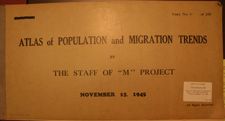 But my main focus was to find and copy everything I could on the "M" Project that I had first come across at the Truman Library. I was not disappointed. Literally thousands of pages of documents exist pertaining to FDR's secret Migration Project, designed to study all the ramifications necessary to handle the millions of post-war refugees that would need a place to live and prosper after the war. Two collections proved most helpful: The Henry Field Papers, and the Henry Field - Isaiah Bowman Reports: Studies of Migration and Settlement. I thought it was indeed revelatory when the archivist had to question the accuracy of the call tag I wrote for the Henry Field Papers, commenting that "rarely has anyone ever used this collection." I find that amazing! How can authors and historians evaluate FDR's response to the persecution of the Jews and others during WWII without examining the goals and aspects of his Migration Project. Henry Field had to seriously lobby to have the papers declassified in the late 50s, personally financing their publication and distributing the full study in 1962. No one was interested. I plan on incorporating information about the "M" Project into the final chapter of my dissertation. But my main focus was to find and copy everything I could on the "M" Project that I had first come across at the Truman Library. I was not disappointed. Literally thousands of pages of documents exist pertaining to FDR's secret Migration Project, designed to study all the ramifications necessary to handle the millions of post-war refugees that would need a place to live and prosper after the war. Two collections proved most helpful: The Henry Field Papers, and the Henry Field - Isaiah Bowman Reports: Studies of Migration and Settlement. I thought it was indeed revelatory when the archivist had to question the accuracy of the call tag I wrote for the Henry Field Papers, commenting that "rarely has anyone ever used this collection." I find that amazing! How can authors and historians evaluate FDR's response to the persecution of the Jews and others during WWII without examining the goals and aspects of his Migration Project. Henry Field had to seriously lobby to have the papers declassified in the late 50s, personally financing their publication and distributing the full study in 1962. No one was interested. I plan on incorporating information about the "M" Project into the final chapter of my dissertation.

 During the first two weeks of June 2008 I had the privilege of participating in the Curt C. and Else Silberman Seminar, conducted by the Center for Advanced Holocaust Studies at the USHMM. While there, I took the opportunity to do some dissertation research. What I found was one of those researcher's dreams-come-true . . . During the first two weeks of June 2008 I had the privilege of participating in the Curt C. and Else Silberman Seminar, conducted by the Center for Advanced Holocaust Studies at the USHMM. While there, I took the opportunity to do some dissertation research. What I found was one of those researcher's dreams-come-true . . .
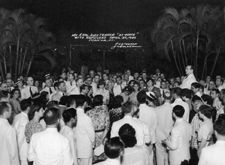 When I visited the photo archives at the USHMM, I inquired about a newly processed collection of photos from Manila and was delighted to find photos of the refugees in Manila that had been donated to the USHMM archives by the Frieder Family, whose fathers were the rescue organizers in the Philippines. The archivist told me she had only just uploaded the images to the server last week. Timing is everything! I asked if I could have the digital files sent to my email and . . . . When I visited the photo archives at the USHMM, I inquired about a newly processed collection of photos from Manila and was delighted to find photos of the refugees in Manila that had been donated to the USHMM archives by the Frieder Family, whose fathers were the rescue organizers in the Philippines. The archivist told me she had only just uploaded the images to the server last week. Timing is everything! I asked if I could have the digital files sent to my email and . . . .
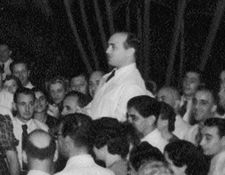 . . . when I opened the files that night I was stunned to see this picture that was taken at a celebration banquet in Manila in 1940. There standing before the assembly was Cantor Cysner! And it looks like he was singing to the audience. This event was dedicated to the generosity of President Quezon who donated his own personal property in Marikina for the construction of refugee housing for the ever increasing numbers of European refugee Jews fleeing to the Philippines for safe haven. . . . when I opened the files that night I was stunned to see this picture that was taken at a celebration banquet in Manila in 1940. There standing before the assembly was Cantor Cysner! And it looks like he was singing to the audience. This event was dedicated to the generosity of President Quezon who donated his own personal property in Marikina for the construction of refugee housing for the ever increasing numbers of European refugee Jews fleeing to the Philippines for safe haven.
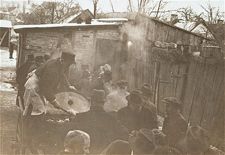 While in the photo archives, I also searched for any new acquisitions on Zbaszyn, the site of the refugee camp for the victims of the Polenaktion of October 28, 1938, when Hitler ordered the mass expulsion of Polish Jews living in Reich territory, abandoning nearly 12,000 at border locations such as Zbaszyn. I found pictures of the Zbaszyn deportations I had never seen before. While in the photo archives, I also searched for any new acquisitions on Zbaszyn, the site of the refugee camp for the victims of the Polenaktion of October 28, 1938, when Hitler ordered the mass expulsion of Polish Jews living in Reich territory, abandoning nearly 12,000 at border locations such as Zbaszyn. I found pictures of the Zbaszyn deportations I had never seen before.
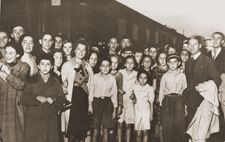 Here we see a group picture of children from Zbaszyn just before boarding the train for the first leg of their immigration to England through the Kindertransports. While Holocaust studies have just in the last few years concentrated on the stories of lost children saved through these transports to England, few have linked their rescue to the Zbaszyn internment, when indeed, it was the plight of these children and the conditions of their confinement at Zbaszyn that inspired rescuers to bring Jewish children across the channel to England to save them from further Nazi persecutions. Here we see a group picture of children from Zbaszyn just before boarding the train for the first leg of their immigration to England through the Kindertransports. While Holocaust studies have just in the last few years concentrated on the stories of lost children saved through these transports to England, few have linked their rescue to the Zbaszyn internment, when indeed, it was the plight of these children and the conditions of their confinement at Zbaszyn that inspired rescuers to bring Jewish children across the channel to England to save them from further Nazi persecutions.
Return to top of page
|